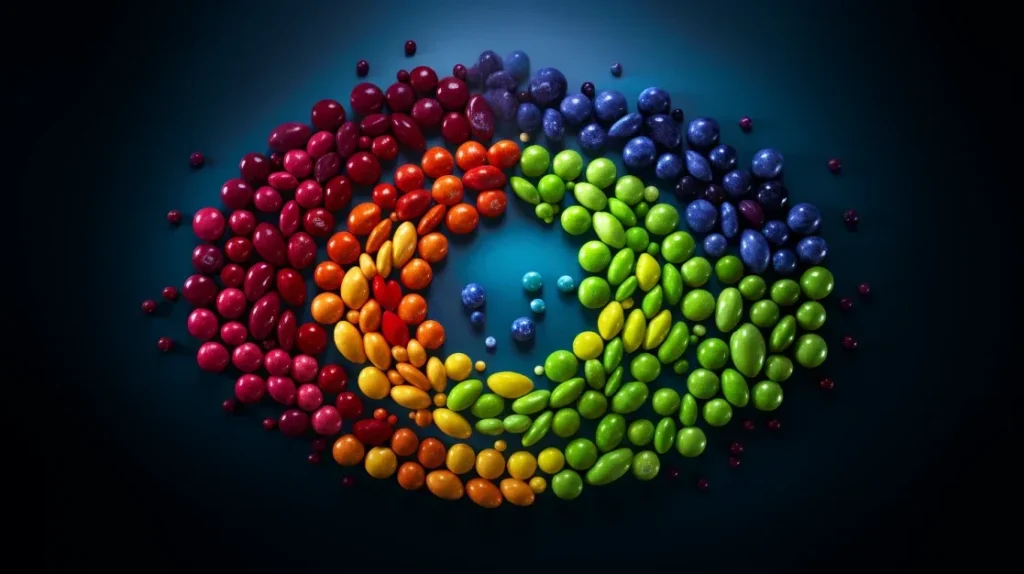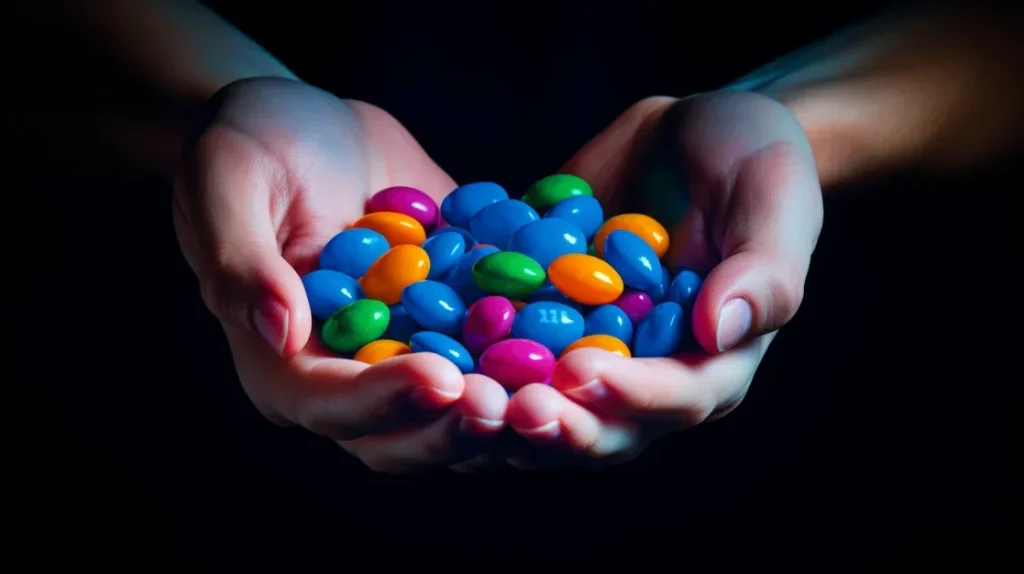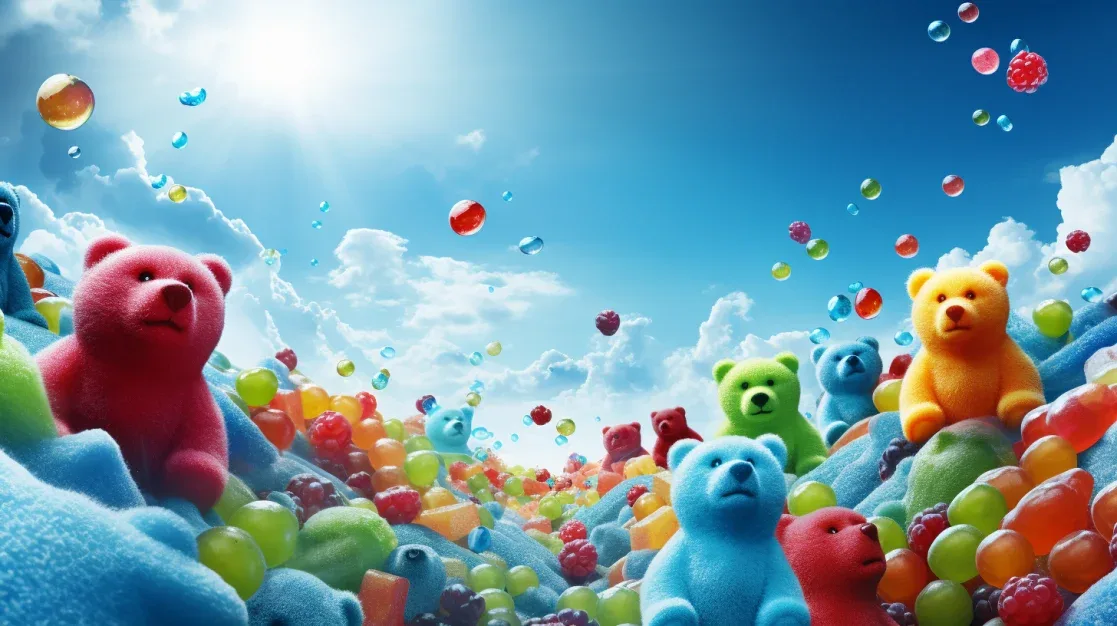Table of Contents
Step right up and prepare to unravel the enigmatic world of blue Skittles! Like a modern-day food detective, you’re about to embark on a journey that will delve deep into the flavors, myths, and more surrounding these captivating candies.
Have you ever wondered why blue Skittles taste so uniquely delicious? Or you’ve pondered the origins of their vibrant hue. Get ready to have your taste buds tantalized and your curiosity satisfied.
In this article, we’ll take a scientific approach to dissecting the mystery behind blue Skittles. As we explore their intriguing history, uncover the secrets of their flavor profile, and investigate the role of artificial colors, prepare to be enlightened by fascinating facts and surprising revelations.
We’ll even dive into limited-edition blue Skittle flavors and examine their evolution. So fasten your seatbelt and get ready for a wild ride through the colorful realm of blue Skittles.
Your analytical mind will be captivated as we explore every aspect of this beloved candy – from its cultural impact to its future possibilities. Get ready for an adventure like no other!
Key Takeaways
- Blue Skittles were introduced in 1989 as part of the limited edition ‘Tropical Skittles’ but became a permanent flavor due to overwhelming popularity.
- The specific flavor combinations of blue Skittles are kept secret by Mars Inc., but there is speculation that it is a blend of raspberry and strawberry. However, the candies have no blue raspberry flavoring, according to the ingredient list and company confirmation.
- Artificial colors, including blue, are used in candies to enhance visual appeal and create excitement. The FDA limits the amount and types of color additives to ensure safety standards.
- Blue Skittles have sparked debates about taste differences from other colors and have released limited edition flavors to cater to consumer preferences. They have become culturally significant, frequently featured in popular media, and associated with fun and excitement.
What Are Blue Skittles?
Blue Skittles are a popular candy known for their vibrant blue color. They are part of the Skittles brand, which features various fruity flavors. While the blue Skittle doesn’t have a distinct flavor, it is often associated with flavors like a wild berry, berry punch, and melon berry.
The mystery of blue Skittles lies in the allure of its unique color. Many people wonder what gives the Skittle its blue hue. The blue coloring is achieved using a food dye called Blue 1, a safe and commonly used food additive.
Blue Skittles have also sparked myths and legends in popular culture. Some believe that blue Skittles have a secret flavor known as “Blue Zkittlez,” while others relate the color to natural phenomena like the blue diamond or active volcanoes.
While the fascination with blue Skittles may seem trivial, the study of myth and the exploration of flavors can profoundly impact mental health. Discovering new tastes and engaging with stories and legends can bring joy and excitement to our lives.
In conclusion, Blue Skittles are a delicious and visually captivating candy. Their mysterious blue color and assortment of fruity flavors continue to captivate candy lovers worldwide.
The Flavor of Blue Skittles

Blue Skittles have become iconic in the candy world, captivating our taste buds with their vibrant hue and bold flavors. Regarding blue Skittles, two popular fruity flavors steal the show – Melon Berry and Berry Punch.
Melon Berry Blue Skittles offers a refreshing blend of juicy watermelon and sweet berries, creating a mouthwatering combination that is both delicious and addictive. With each bite, you’ll experience a burst of fruity goodness that will leave you craving more.
On the other hand, Berry Punch Blue Skittles deliver a tangy and punchy flavor profile that will awaken your taste buds. This flavor combines the tartness of various berries with a hint of citrus, creating a whirlwind of taste sensations that is both intense and satisfying.
Whether you prefer the refreshing subtlety of Melon Berry or the boldness of Berry Punch, these flavors are the perfect summer candy to enjoy at picnics, parties or simply as a sweet treat to brighten your day.
So grab a handful of blue Skittles, and let your taste buds embark on a fruity adventure like no other. Unleash your inner candy connoisseur and discover the irresistible flavors that have made blue Skittles a beloved favorite among candy lovers worldwide.
Debunking the Greek myth of blue raspberry flavor
Contrary to popular belief, the myth of blue raspberry flavor has been debunked. Blue Skittles do not contain any blue raspberry flavoring. Here are four reasons why:
- Artificial Flavoring: Blue Skittles get their distinct taste from a combination of artificial flavors like berry and citrus, but not blue raspberry.
- Color Association: The blue color may lead people to associate with blue raspberries, but in reality, the color represents the candy’s appearance.
- Ingredient List: Upon examining the ingredient list, there is no mention of blue raspberry or related extracts.
- Manufacturer Statement: The company behind Skittles has confirmed that their candies have no blue raspberry flavor.
Now that we have debunked this misconception about blue Skittles, let’s delve into the flavor profile of these vibrant candies.
The actual flavor profile of blue Skittles
Let’s look at what flavors make up the vibrant profile of blue Skittles. Blue Skittle mystery flavor has intrigued consumers for years, as it stands out among the rainbow of colors and tastes. A food scientist or journalist would approach this topic analytically, carefully examining the ingredients, flavors, and production methods to understand the science behind these unique candies. To shed light on the subject, here is a breakdown of the flavor components found in blue Skittles:
| Flavor Component | Description |
|---|---|
| Berry Blast | A mix of various berries |
| Blue Raspberry | Tart and sweet raspberry essence |
| Wild Berry | Bursting with fruity goodness |
| Cool Melon | Refreshing melon sensation |
Consumer preferences for blue Skittles may vary depending on individual taste buds, but this combination offers a delightful blend of fruity and refreshing notes. Now let’s explore the role of artificial colors in shaping Skittles’ flavor profiles.
The Role of Artificial Colors

When exploring the role of artificial colors in candies, it is important to consider the FDA regulations on food coloring.
A food scientist or journalist would approach this topic analytically, carefully examining the ingredients and production methods to understand the science behind blue Skittles and their unique characteristics.
Objectivity is crucial in presenting factual information about flavors, ingredients, and any myths or controversies surrounding blue Skittles.
Furthermore, an informative approach would delve into the history, manufacturing process, and potential health effects of consuming blue Skittles to provide comprehensive information for curious readers.
Exploration of artificial coloring in candies
Imagine discovering the secret behind the vibrant artificial coloring in your favorite candies and uncovering whether it’s safe for consumption. As a food scientist or journalist, you would approach this topic analytically, carefully examining the ingredients, flavors, and production methods to understand the science behind blue Skittles and their unique characteristics. The psychology of color perception in candy plays a significant role in our enjoyment of these treats. Companies use artificial colors to enhance visual appeal and create a sense of excitement when consuming them. However, there is controversy surrounding artificial colors in food due to potential health effects. To grab your attention, here is a table showcasing some common artificial colors used in candies:
| Color | Commonly Used In |
|---|---|
| Blue | Skittles, M&Ms |
| Red | Twizzlers, Swedish Fish |
| Yellow | Lemonheads, Starburst |
| Green | Sour Patch Kids, Jolly Ranchers |
| Orange | Reese’s Pieces, Tic Tacs |
Understanding the role of artificial coloring in candies sets the stage for exploring FDA regulations on food coloring.
FDA regulations on food coloring
The FDA’s regulations on food coloring ensure that the use of artificial colors in candies meets strict safety standards, taking into account potential health effects and consumer well-being.
A food scientist or food journalist would approach the topic of blue Skittles with a keen analytical mindset. They would carefully examine the ingredients, flavors, and production methods to understand the science behind the blue Skittles and their unique characteristics.
Regarding health concerns with food coloring, the FDA has set limits on the amount and types of color additives used in foods. This is to prevent any potential adverse effects on human health. However, some individuals may still have sensitivities or allergies to certain artificial colors in blue Skittles.
Understanding these regulations and potential health concerns provides a foundation for exploring the controversy surrounding blue Skittles.
The Blue Skittle Controversy

For those who have debated the existence of blue skittle flavors, let’s dive into the controversy surrounding this mythical treat.
As a food scientist or journalist approaches the topic, we must examine the ingredients, flavors, and production methods to understand the science behind blue cross and their unique characteristics.
The controversy surrounding blue Skittles mainly revolves around the taste debate. Some claim that blue Skittles have a different flavor from other colors, while others argue that they all taste the same. To determine the truth, it is crucial to analyze each ingredient and its specific contribution to the overall taste profile of blue Skittles. By doing so, we can provide accurate details about any myths or controversies surrounding this candy.
Now let’s explore another intriguing aspect of blue Skittles: limited edition flavors.
Limited Edition Blue Skittle Flavors

Limited edition blue Skittle flavors have become a source of excitement and anticipation for Skittles fans. These special releases offer unique flavor combinations that leave our taste buds craving more. One example of a limited edition blue skittle flavor is Blue Raspberry Lemonade, which combines the tartness of lemonade with the sweetness of blue raspberry. Fans have reacted positively to these limited edition flavors, eagerly awaiting new releases and collecting them like prized possessions. This shows that consumers are interested in traditional skittle flavors and enjoy exploring new taste experiences. Moving forward, let’s delve into the evolution of Skittles flavors…
The Evolution of Skittles Flavors

The evolution of Skittles flavors has seen numerous changes and updates to the lineup over the years.
Skittles has expanded from the original five fruit flavors to include a wide variety of unique and innovative flavors.
The brand has continually experimented with new flavor combinations, pushing the boundaries of taste and offering consumers diverse options to satisfy their cravings.
Changes and updates to the Skittles flavor lineup
One interesting tidbit about Skittles flavors is that there have been changes and updates to their lineup over the years. Limited edition flavors are often introduced to cater to consumer preferences and keep the brand fresh. For example, Skittles has released special editions like “Darkside” with darker fruit flavors, “Sweet Heat” with spicy flavors, and even a “Pride Pack” featuring vibrant colors and fruity tastes.
These limited-edition varieties allow Skittles to experiment with different flavor combinations and appeal to a wider range of taste buds. It’s fascinating how they continue to innovate and surprise us with new flavors. Now let’s delve into the next section about innovation and experimentation with new flavors without missing a beat.
Innovation and experimentation with new flavors
Let your taste buds embark on a flavor-filled adventure as Skittles fearlessly dances with unexpected combinations, like a symphony of surprises for your mouth. As the Skittles brand continues to innovate, they constantly experiment with new flavors to cater to evolving consumer preferences.
Here are three innovative combinations that have delighted candy enthusiasts worldwide:
- Tangy Mango and Sweet Pineapple
- Zesty Lemon and Fiery Lime
- Juicy Watermelon and Refreshing Cucumber
These bold flavor pairings showcase Skittles’ commitment to pushing boundaries and creating unique taste experiences. Skittles creates an explosion of flavors that captivate the senses by combining contrasting tastes. The science behind these innovative combinations lies in understanding how different flavors interact on the palate, resulting in a harmonious blend of sweetness, tartness, and tanginess.
This exploration into new flavors sets the stage for further examination of the science behind flavor perception in the subsequent section.
The Science Behind Flavor Perception

Contrary to popular belief, our perception of flavor is influenced by a complex combination of taste buds and olfactory receptors. Flavor perception research has shown that taste bud sensitivity varies among individuals, leading to differences in how we perceive different flavors. The science behind blue Skittles and their unique characteristics lies in carefully selecting and combining ingredients to create a distinct taste profile.
Blue Skittles are made using artificial coloring agents such as Brilliant Blue FCF (Blue 1) or Indigotine (Blue 2), which give them their vibrant blue hue. Regulatory bodies have approved these colorants for food products, including candies like Skittles. By understanding the science behind the production methods and ingredients used in Blue Skittles, we can gain a deeper appreciation for their flavors and enjoy them with newfound knowledge.
Frequently Asked Questions
What is the nutritional information of blue Skittles?
The nutritional information of blue Skittles is impacted by artificial food coloring. As a food scientist or journalist, you would analyze the ingredients and production methods to understand the science behind these unique candies.
Are blue Skittles vegan or vegetarian-friendly?
Blue Skittles are vegan and vegetarian-friendly, making them popular among children. They contain plant-based ingredients and do not use any animal products in their production.
How many blue Skittles are in a standard bag?
Blue Skittles are made using natural and artificial ingredients, including food dyes for the blue color. They don’t taste different from other flavors, but people love them due to their vibrant appearance and association with the popular blue raspberry flavor.
Can blue Skittles be purchased individually or only in packs?
Blue Skittles can be purchased individually or in packs. For example, you can find them sold separately at candy stores. They are also available in mini bags, making them convenient for snacking on the go.
Are there any known health risks associated with consuming blue Skittles?
There are no known health risks associated with consuming blue Skittles. They are exploring the psychological impact of blue on food consumption and debunking the myth that blue Skittles are made from artificial coloring.
Conclusion
In conclusion, blue Skittles have captivated consumers with their unique flavor and vibrant color. Approximately 30% of Skittles sold in the United States are blue, making it one of the most popular flavors. This statistic vividly shows the widespread love for these blue candies and highlights their significant impact on the candy market.
As a food scientist or food journalist, you would be intrigued to know more about the origins of blue Skittles. The mystery of their flavor and the controversy surrounding their use of artificial colors add to their allure. Exploring the myths and rumors surrounding blue Skittles can provide valuable insights into their creation and the choices made by the manufacturers.
Furthermore, blue Skittles continue to evolve in flavor, offering new variations and combinations. This constant innovation keeps consumers interested and engaged as they eagerly anticipate the next blue Skittles flavor. The ever-changing nature of blue Skittles adds to their mystique and ensures their continued fascination for scientists and candy enthusiasts.


